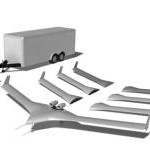
A new X-Plane designed and developed by Lockheed Martin Skunk Works is expected to fly this year at the Edwards Air Force Base in the California Mojave desert, becoming a key test asset for the Air Force Research Laboratory (AFRL)-led Multi-utility Aeroelastic Demonstration Program (MAD). These tests will contribute to AFRL’s follow-on work to SensorCraft, a class of High Altitude Long Endurance (HALE) vehicles intended for surveillance as well as telecommunication relay and environmental sensing.
On its AFRL lead mission the 28-ft.-span vehicle will test active flutter suppression and gust load alleviation. Following that phase the X-56A will be transferred to NASA, to support NASA Dryden Flight Research Center, to assist the research of lightweight structures and advanced technology for future low-emissions transport aircraft. Active flutter suppression and gust load alleviation considered vital for the successful development of the slender, lightweight, high-aspect-ratio wings that could be used by future transports as well as intelligence, surveillance and reconnaissance UAVs.
Designed as a cranked delta planform the X-56A bears similarity to former jet-powered Lockheed Martin UAV programs such as the P-175 Polecat, RQ-170 and DarkStar. It will be powered by twin JetCat P240 turbojets, and be configured for easy wing replacement. According to Guy Norris of Aviation Week, The flight-test package will include two identical center bodies measuring 7.5 ft. long, as well as four sets of constant-chord wings. One set will be stiff for baseline flight tests, as well as follow-on research, while the remaining three will be identical flexible wings made with lighter skin material for flutter testing.
The X-56A will test to the edge of the flight envelope where flutter occurs. Flutter is the potentially catastrophic dynamic coupling that can occur between the elastic motion of the wing and the aerodynamic loads acting on it. If a test goes too far and a wing fails in flight, the X-56A is fitted with a fuselage-mounted ballistic parachute recovery system.
What motivated AFRL and NASA to join forces to develop the X-56A was similar interest in pursuing configurations for future aircraft. AFRL MAD Program Manager Pete Flick says the SensorCraft studies explains, “this led us to very different configurations that are inherently more flexible with high-aspect-ratio wings. Gust-load alleviation and flutter suppression are two key technologies we needed to pursue, and there was no testbed out there where we could test active flutter suppression without a lot of risk. So we went out to develop a vehicle specifically for that purpose.” Derived from the ‘Multi-Use Technology Testbed’ (MUTT) design, the X-56A is in final assembly at GFMI Aerospace and Defense, a Fountain Valley, Calif.-based engineering company specializing in prototype and mockup development. The aircraft is due to be delivered to Lockheed Martin in late April and will be transported to Edwards AFB in June. Flights with the 452nd Flight Test Squadron, part of the 412th Test Wing, will begin at the North Base in July and continue through September. Following an approximately 25-hr.-long flight test effort, the X-56A is expected to transfer to NASA by year’s end.
This news item was also reported by Brad Lucht on the Defense-Update Linkedin group.




















